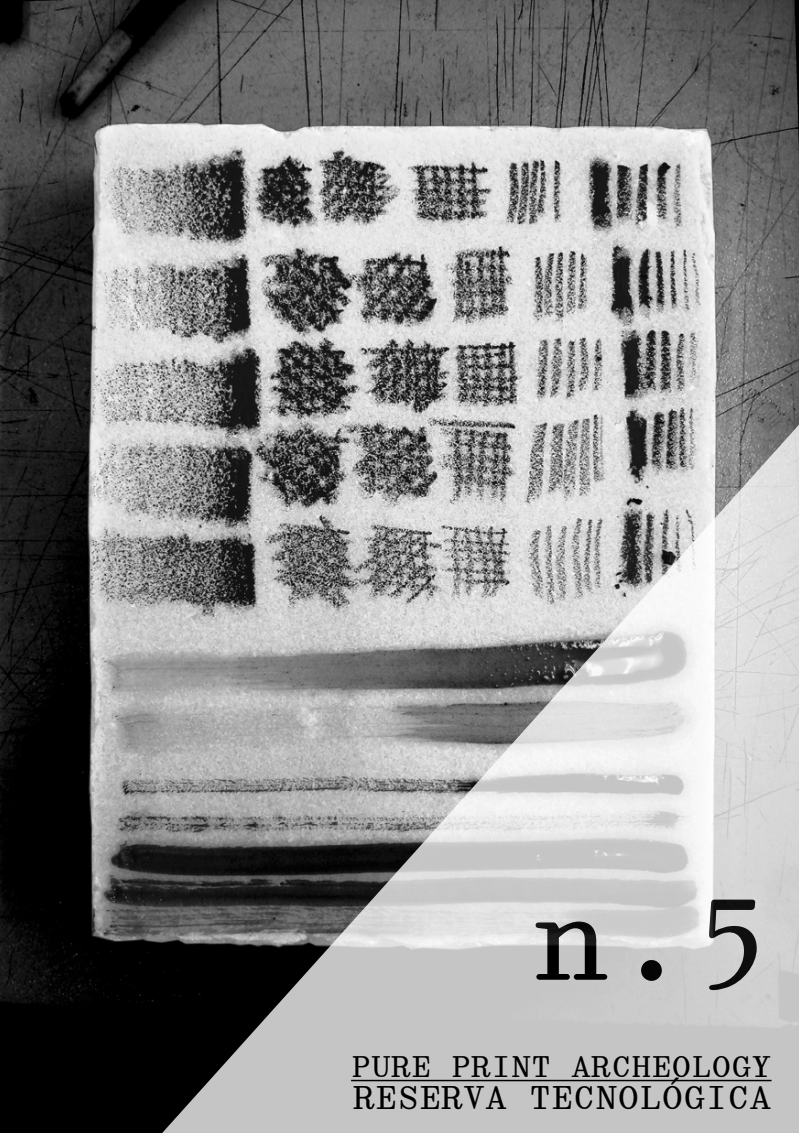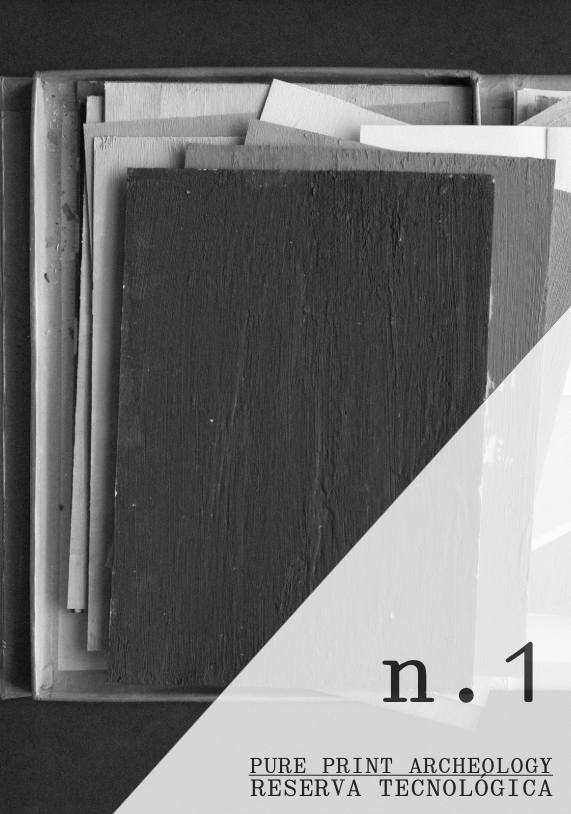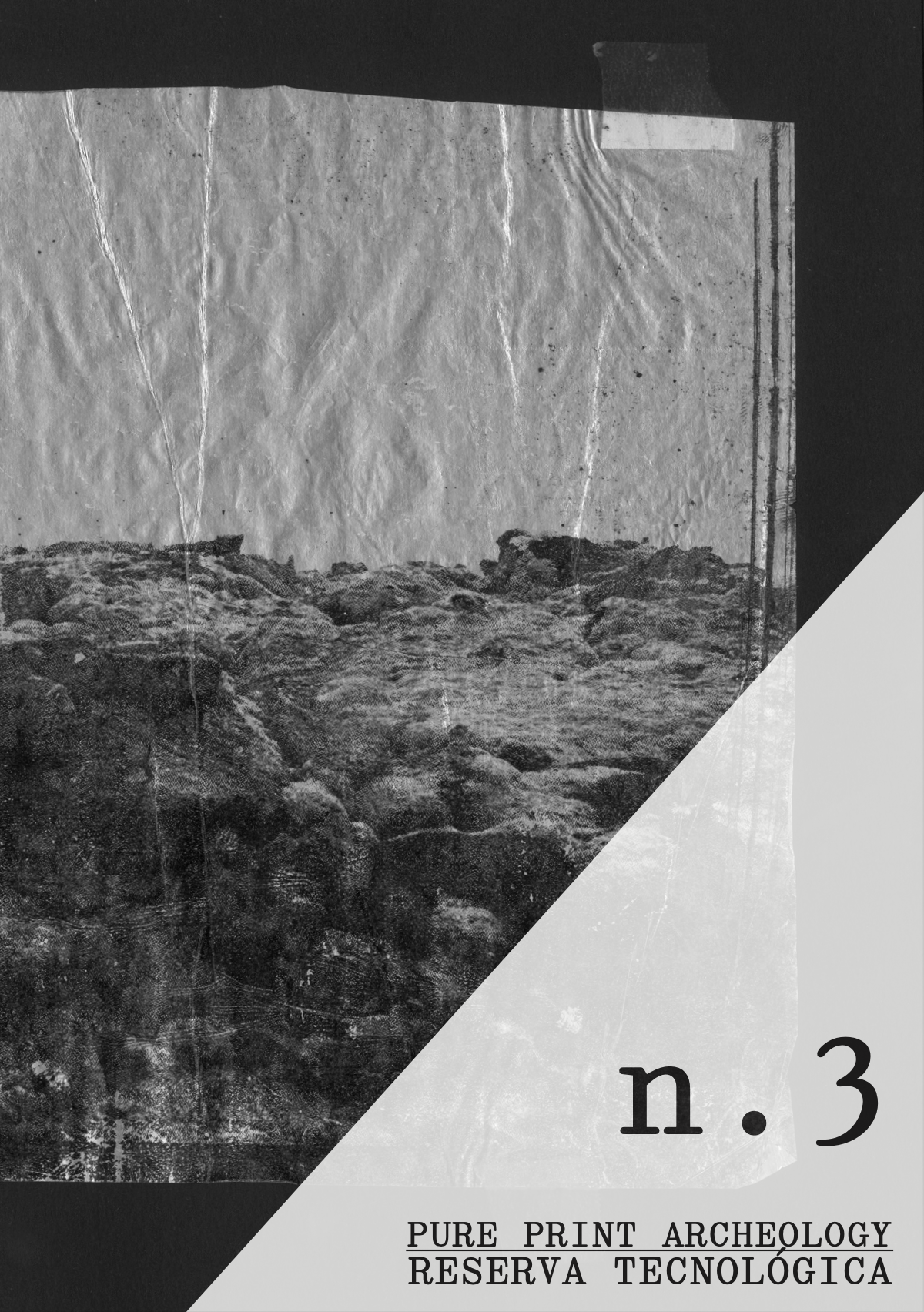
livro
Reserva Tecnológica n.5
Reserva Tecnológica nº.5 compila e publica “fichas técnicas expandidas” propostas pelo Pure Print Archeology, desenvolvidas para a exposição Nomade, que foi organizada em janeiro de 2024 e apresentada na Fundação Marques da Silva (Porto).
- Edição
- Graciela Machado, David Lopes
- Ano
- 2024
- isbn | issn
- 2975-8661
Editorial
Atelier NOMADE: lithography in situ, presented in january 2024, is an all-encompassing project that brings together illustration, architecture, geology, and urban geography through the practice of lithography, allowing its participants to take part in a unique and enriching experience. Throughout this event, participants got involved in a multidisciplinary practice, exploring the complexity and interconnectedness of these disciplines by mapping the city of Porto’s terrain and the lithographers who lived and worked in the city.
Focusing on an art form more commonly practiced and associated with a designated workshop space and challenging the sepaation between cultural and architectural heritage and artistic investigation, this project promoted this dialogue by using lithography as a means to approximate lithography itself with urban territory and the visual archives that originate from this same territory.
This project’s program was organized around a technologically based approach, centered on getting intimately acquainted with the tools used in the art of lithography, making use of raw materials such as supports, pigments, among others of local extraction, the study of lithography and its relationship with the history and growth of the city and, finally, the application of these concepts through in situ excursions throughout the city to practice in situ lithography. With the help of technological archaeology, artistic investigation, and experimentation within the medium of lithography, the program proposes to reflect upon relevant ecological questions, reaffirming the need to rethink the dualities of human nature and human city. Every stage of the proposed program was established to challenge what we perceive to be a gap between technological and historical knowledge, giving particular importance to relearning processes and instruments used as tools for the observation and the questioning of what we perceive to be real. This is something we believe transcends all of these disciplines and areas of knowledge and that has the potential to be part of a significant discussion for future generations.
Historically, lithography has been associated with scientific development, allowing it to access raw materials, develop tools and solutions based on this same development, construct equipment, and develop printing processes of both small and large scale. The very history of the development of the city-scape allows us a glimpse of the importance of this graphic industry and the way in which it took part in the transformation of the urban landscape.
Atelier NOMADE: in situ lithography aimed to bridge the gap between the scientific and the technological, analyzing the use of portable equipment, as well as the need to respect native and local resources, suggesting pathways throughout the city that reveal the importance of lithography’s graphic industry.
The starting point was FBAUP’s printmaking workshop, where we will discuss lithography’s artistic relevance and intimate relationship with artisanal processes. At this stage, we will reaffirm the need to produce artwork within the printmaking workshop based on what we call technological archaeology, in addition to confronting this method’s relevance in the study of Fine Arts, giving special importance to its use of instruments, matrixes, and protocols. We demonstrated how, for example, making use of equipment that has been unused for decades, or perhaps just the mere act of observing the gestures of preparatory tasks, can be relevant within a learning environment and give historical context to its inherent graphic heritage. The next stage of the program was dedicated to discussing lithography on a national and international scale, additionally discussing its relationship with geology as well as its presence on specific buildings found around the city that to this day reveal the part it played in the transformation of the city as a whole. We wanted to create a sort of experimental “mobile laboratory” that functioned until we reached the nomadic studio that was setted in the Marques da Silva Foundation. The foundation itself is an archive dedicated to the city’s architectural and artistic legacy, and where we tested our ability to adapt and to question how the practice of lithography can be rebuilt today.
The program was comprised of a week-long intensive workshop designed to construct the necessary materials for the in situ method, to strengthen the collaborative process in artistic investigation, to allow for the use of an interdisciplinary approach in research, to deconstruct preconceived ideas related to the use of different technologies in art and, finally, to question the idea of space, of archive and the city.
We designed this intensive model so it would combine these different components seamlessly, taking shape in short-term mobility exercises around the city, consulting historical archives, drawing and printing, setting up the resulting exhibition, and, finally, discussing the results to promote innovative methods of teaching and learning the art of lithography.
Beyond our interest in practicing lithography in such a way that explores its historical and technical legacy in contexts both local and global, the Atelier NOMADE brought together geology, geography, architecture, illustration, and design as its main areas of research and image production. We’ve found that these areas have a deep-rooted connection with lithography, the latter having played significant roles in different points of these disciplines’ history.
Geology plays a crucial part in providing us with informed notions about the physical formation of the city.
We see urban geography as a dynamic background that molds human environments. Through specific case studies, the participants will examine how geography influences the distribution of urban spaces, connecting the exercises planned for the workshop with the city’s physicality.
Architecture is like a narrative that molds the very identity of the city. Through practical exercises and case studies, the participants will explore how buildings and urban structures reflect the historical evolution and cultural influences that contribute to the unique aesthetic of a place.
Illustration and design establish the importance of artistic expression in understanding and representing the city and its multiple narratives. We will use lithography to capture the visual essence of the city and its multiple cultural and historical layers. We will explore these narrative possibilities by drawing as we move through the city and by analyzing editorial artifacts from the 19th century, contemporaneous with the development of lithography and chromolithography in our local and national context. Contact with this printed material reinforces lithography’s part in the democratization of publications and editorials, demonstrating how its use allowed for the creation of layouts in which text and image work in tandem to communicate political, commercial, and ideological content or even entertainment. We will explore the development of this graphical, reproductive, and distributive potential of printed material by analyzing newspapers and bulletins produced by Rafael Bordalo Pinheiro and Sebastião Sanhudo (1851-1901), founder of Litografia Portuguesa, a great contributor to the cultural sphere in Porto, as well as a renowned illustrator.
To summarize, Atelier NOMADE: in situ lithography attempted to provide an enriching and collaborative work week to be experienced in different places and contexts. Our activities have been devised for students, and schoolars of the Faculty of Fine Arts of the University of Porto, and international group from the Schools of cole Supérieur d’Art et Design de Saint-Étienne, Académie Royale des Beaux Arts de Bruxelles École supérieure des Arts. They worked around four places in the city, where there would’ve been alocated the lithography workshops first recorded in Porto.
Graciela Machado
Júlio Dolbeth
Rui Vitorino dos Santos
Sobre
Reserva Tecnológica é uma publicação períodica, lançada após uma exposição organizada pelo grupo Pure Print Archelogy (i2ADS/FBAUP). Reserva Tecnológica publica fichas técnicas expandidas, preparadas especificamente para acompanharem os objetos em exposições organizadas pelo PPA. As fichas técnicas expandidas são habitualmente constituídas por um texto e por ilustrações de carácter instrutório, produzidas pelos artistas e investigadores. Reserva Tecnológica publica as fichas técnicas na língua originalmente redigida para o contexto da exposições apresentadas. Na mesma publicação as fichas técnicas poderão surgir com diferentes traduções. Reserva Tecnológica não pretende ser um catálogo mas um objeto editorial autónomo, que dá a comunicar a um público abrangente e não especializado, a produção e a investigação do PPA.


